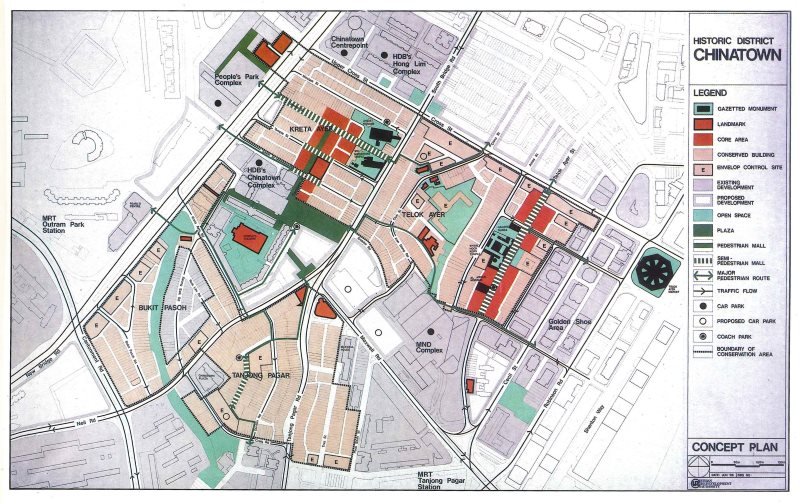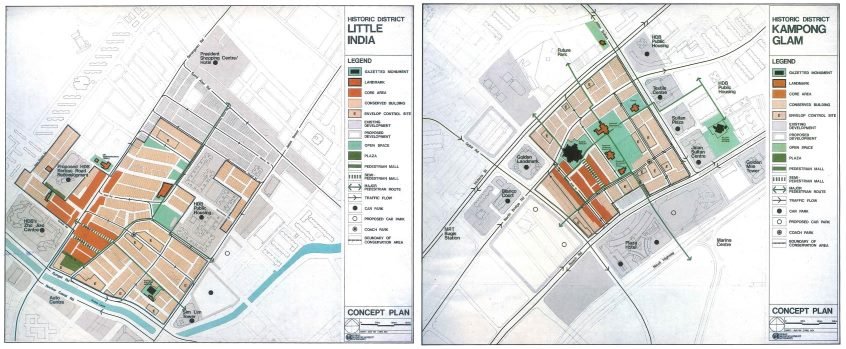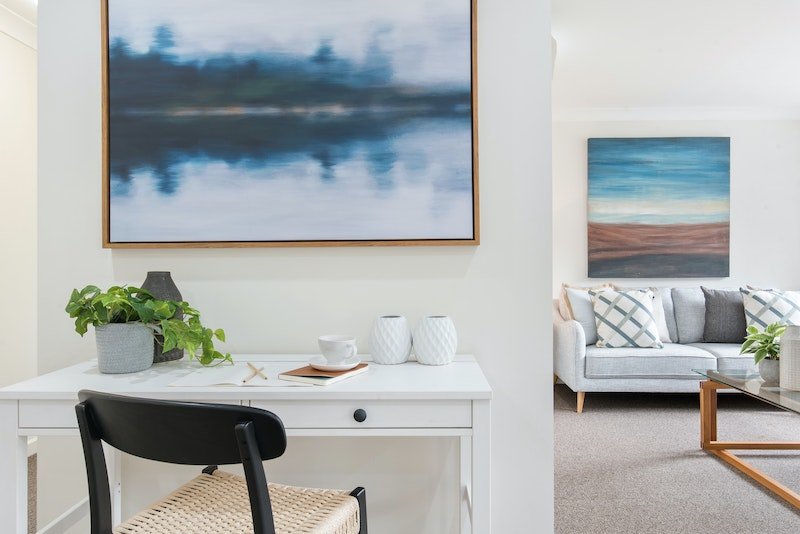From sketching ideas on paper, to doing extensive archival research, crunching numbers and persuading people – it took seven years to make the case for conservation.
Koh-Lim Wen Gin joined URA in 1974 as a young architect drawn to the ambitious effort to transform the city centre. She was instrumental in leading the crucial conservation efforts on a large scale. Her first assignment given to her by Alan Choe was to draw the reclamation profile of Marina Bay. The opportunity to conserve the historic districts in the city centre came when plans to build the Mass Rapid Transit (MRT) system was announced in May 1982. She had just come back from maternity leave in September 1982 and was appointed to head a small urban design team.
The announcement to proceed with the building of the MRT network offered the chance for the team to initiate a comprehensive review of the Central Area, which led to the development of the Central Area Structure Plan in 1985, a defining plan that provided a framework for sustainable development in the city centre. It also clearly identified the need to conserve the low-rise historic districts as a whole while balancing this with denser and more high-rise developments around the MRT stations.

Koh-Lim Wen Gin (standing in the middle) in discussion with staff on the plans for the Central Area with the decision to proceed with the building of the MRT network in 1982.
It took seven years to make the case for conservation a reality on a more comprehensive scale.
You lived in a shophouse for a short while and had some early encounters of the historic districts then.
Wen Gin: I remember as a kid, I would follow my mother to Chinatown’s wet market to buy fresh produce and to Arab Street to buy textile. I remember walking past Sago Street lined with death houses with great fear. My impression then of these places was that they were fascinating but were messy and smelly at times. I also lived in a shophouse along Orchard Road and had joined my younger sister in a school at Mount Sophia. I remember walking to the school through the Istana.
What were your thoughts then when reviewing the Central Area?
Wen Gin: When we looked at the city centre, we asked ourselves, can you imagine if we tear down all these old historic areas where it has its charm and historical roots and give you a sense of identity and history. And you just build high-rise glass boxes, imagine they are all wiped out today and in place they are all glass boxes, Singapore will be a city without soul, without history and without feeling. The younger generation will have to go to a library to turn the pages and know what it was like then. At that time, we also visited other cities and it made us think that cities may begin to look alike if everything was high-rise and modern.
What were some of the early considerations in thinking about heritage and conservation?
Wen Gin: As a planner and architect, we looked at heritage from the point of view of how the city should evolve as a total environment. If you take a macro perspective on the city itself, the city needs the soul and the character and the history needs to be maintained. And also when you do a city plan, there should be a layering effect. You do not just build in every square foot high-rise blocks where there is no sense of space, vista, urban window or certain vantage points where you can comprehend the beauty of the city.
We also saw the early settlements where Stamford Raffles marked out in his town plan as really the start of Singapore. Why it is so important that we must conserve Chinatown, Little India, Kampong Gelam is because these are the areas designated as the ethnic areas. Prior to the early 1980s, there were attempts to conserve these heritage areas but it was done on a piecemeal basis such as at Murray Street or Cuppage Terrace.
Tell us more about the Central Area Structure Plan.
Wen Gin: In the plan, with the MRT network determined, we recommended suitable corridors along the MRT routes and around stations, which could have high-rise and high-density developments. This allowed us to be able to conserve or retain significant districts such as the Civic District, Singapore River, Chinatown, Little India, Kampong Gelam and hill parks such as Fort Canning Hill and Pearl’s Hill.

Concept Plan for Chinatown produced as part of the conservation manual series for Chinatown, Little India and Kampong Gelam in July 1988
They are what we call the lungs of the city. They are low-rise. They naturally serve as lungs of the city. In a way, this is where Singapore started its first developments. And we felt that they should be conserved on an area basis. The plan also envisaged the extension of the downtown core, expanding the Central Business District into the reclaimed land at Marina Bay.
How did you address the initial scepticism in the early years?
Wen Gin: Everybody looked at us and say, all these crummy looking buildings about to collapse, why are you advocating we should conserve them? We had to present our argument and champion very hard. What we did was we restored one of the shophouses at Neil Road over three months as a demonstration project to show what it was and how it can become. And why it is very liveable. If you design and build thoughtfully, buildings can be very liveable and adaptable for whatever use you are going to put in it. So we demonstrated how and why. We worked with the media to write feature articles almost every week to impress upon everyone why you should not be demolishing, why you should restore, how you restore and so on.
We staged various exhibitions, in 1986, the first major one on the Conservation Master Plan (to conserve 10 historic districts) to get public buy-in and also exhibited conservation guidelines in 1988 including publishing a set of conservation manuals for each of the historic districts to raise awareness and understanding on how we can maintain and enhance our historic buildings. When the 10 historic districts were gazetted for conservation in 1989, our photographer walked every street to capture each shophouse and these contributed to developing a set of façade guidelines.
For the conserved areas beyond the historic districts, what was one major challenge in balancing the old and new?
Wen Gin: We knew that it would be very difficult to obtain approval to conserve these areas in the secondary settlements outside of the city centre as they are located immediately adjacent to new high-rise developments. The loss of potential became an issue. If we push for full conservation, we may end up losing the whole lot.
We worked long hours, brainstormed and studied the details and came up with a creative solution of an integrated old and new approach.

The concept plans for Little India and Kampong Gelam as part of the manual series published in 1988
This approach requires only the front main building to be conserved while the rear service block together with the service yard can be demolished and redeveloped higher such that it does not compromise the scale of the main building that is to be conserved and as seen from the main street. By doing so, we were able to retain the charming streetscape and the owners were able to achieve the allowable floor area.
You have stayed in URA for 34 years. What has kept you going?
Wen Gin: You have to first believe in what you can do and what you are doing. If you have the belief, the confidence and you have the passion, even you get a knock on your head, you probably just cry for one night. The next morning, you get up and say, hey, I am going to move again.
You need perseverance. If you do not have perseverance, it will be very easy to say, forget it, I change job. Also, you must be able to stay long enough in the job to do all these things and to see the results. Because when you are able to see the results of the effort you put in, you get that sense of satisfaction. I was fortunate that throughout my 34-year career, my team members were all very passionate. Together, we worked hard and long hours to achieve our goals to transform Singapore into a global city of excellence.
This article is part of ’30 Years of Conservation in Singapore since 1989′, a special supplement that presents 30 reflections and stories of personal and collective struggles and triumph in charting Singapore’s conservation efforts in the last 30 years. The complete supplement will be coming to our website soon.
Source: https://www.ura.gov.sg/Corporate/Resources/Ideas-and-Trends/Making-the-Case




